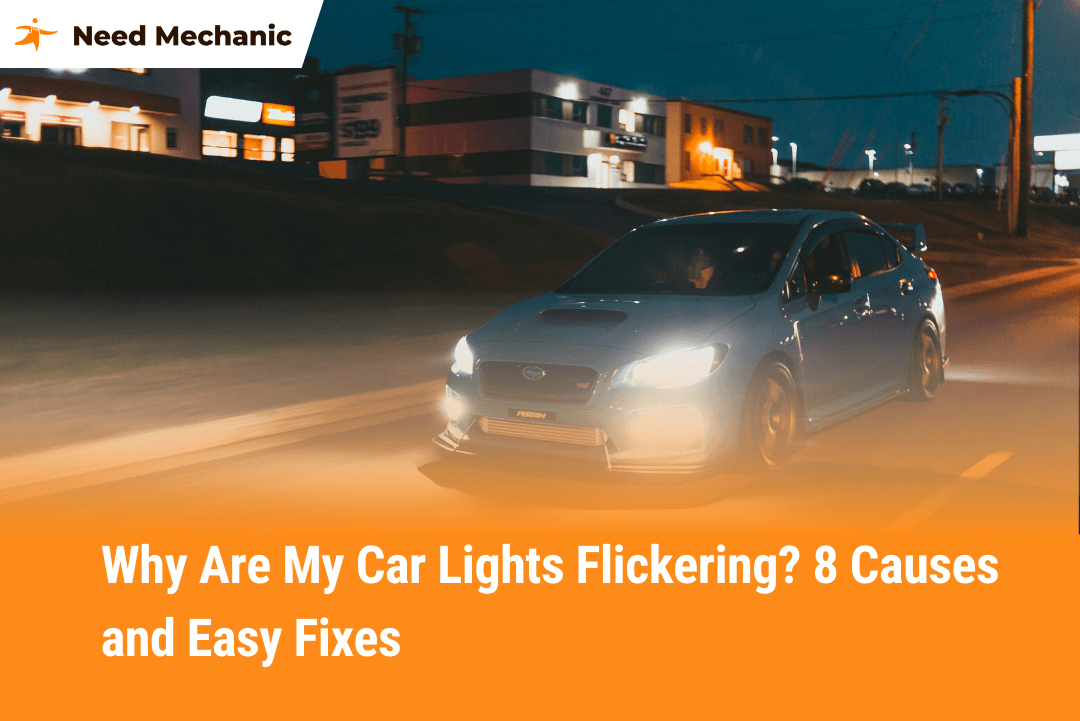Your car lights are flickering because the electrical system is not getting a steady supply of power. This is often caused by a bad alternator, weak battery, loose wiring, or poor grounding. These problems can make headlights dim, dashboard lights flash, or interior lights pulse, and they are warning signs that something needs attention before it leads to a breakdown. In this guide, you will learn the eight most common reasons car lights flicker, how to fix each one, and how to prevent it from happening again.
Understanding Why Car Lights Flicker
Your vehicle’s lighting system depends on electricity. This electricity comes from two main sources. The battery stores electrical energy and powers your car when the engine is off. The alternator generates electricity while the engine is running and keeps the battery charged.
If either the battery or alternator is not working correctly, or if the wiring between them is damaged, your lights may start to flicker. Sometimes it is caused by something small like a loose connection. Other times, it can be a sign of a bad alternator or another serious electrical problem.
1. Bad Alternator
A failing alternator is one of the most common causes of flickering car lights. The alternator converts mechanical energy from the engine into electrical power. It also recharges the battery while the engine is running. When it is not working properly, you may notice:
- Headlights that dim or flicker while driving
- Dashboard lights that fade or brighten without warning
- Unusual noises from under the hood
- Electrical accessories such as power windows or the radio working more slowly than usual
Inside the alternator are parts like the voltage regulator and brushes. These can wear out over time, reducing the alternator’s ability to provide steady electricity. This uneven flow of power causes the lights to flicker.
Solution: If you see other signs of a bad alternator along with flickering lights, have it tested as soon as possible. Often, the best long-term fix is to replace the alternator.
2. Weak or Dying Battery
A battery that is old or worn out may not be able to maintain consistent power. This often causes lights to flicker, especially when starting the car or using several electrical accessories at the same time.
Common signs of a failing battery include:
- Slow engine cranking when you turn the key
- Dim lights during startup
- Needing jump-starts more often
- A battery warning light glowing on the dashboard
A weak battery can also put extra strain on the alternator, which may cause both components to fail sooner.
Solution: Have the battery tested with a multimeter or at an auto parts store. If it is more than three to five years old, replacing it is often the most reliable choice.
3. Loose or Corroded Battery Terminals
Even a new battery can cause flickering lights if the terminals are loose or corroded. Corrosion builds up over time from moisture and battery acid, blocking the flow of electricity.
Signs of this problem include:
- White or blue-green powder on the battery posts
- Electrical issues that come and go
- Lights that flicker when driving over bumps
Solution: Disconnect the battery starting with the negative cable. Clean the terminals with a battery terminal brush and a mixture of baking soda and water. Reconnect the cables tightly to ensure a solid connection.
4. Faulty Voltage Regulator
The voltage regulator manages how much voltage is sent into the car’s electrical system. If it fails, it can send too much or too little voltage, which causes lights to flicker or change brightness.
Possible symptoms include:
- Lights that rapidly brighten and dim
- Other electrical parts acting unpredictably
- Battery charging too much or not enough
Solution: Many voltage regulators are built into the alternator. If it is faulty, you may need to replace the entire alternator assembly.
5. Damaged or Loose Wiring
Your car’s electrical system uses many wires to send power from the battery and alternator to different components. If any wire is damaged, frayed, or loose, it can interrupt the power flow and cause lights to flicker.
Why it happens:
- Normal wear and tear over time
- Damage caused by rodents chewing wires
- Poor-quality repairs or incorrect installation of parts
Solution: Inspect the wiring around the battery, alternator, and headlights. Repair or replace any damaged sections and make sure connections are secure.
6. Failing Headlight Bulbs or Sockets
Not all flickering is caused by the electrical system. Sometimes the headlight bulbs themselves are failing. The sockets that hold the bulbs can also corrode or loosen.
Symptoms to look for:
- Only one headlight flickers or goes out completely
- Flickering gets worse when hitting bumps
- Bulbs appear burnt out or cloudy
Solution: Replace worn-out bulbs and check sockets for damage. Clean or replace sockets if corrosion is present.
7. Failing Ground Connection
Your vehicle’s electrical system needs ground connections to complete the circuits. If a ground wire is loose, corroded, or damaged, it can cause flickering lights.
Signs of a poor ground include:
- Multiple electrical issues happening at once
- Lights flicker less or stop when you move a wire by hand
Solution: Find the ground wires, often connected to the chassis near the battery, and clean or tighten them.
8. Overloaded Electrical System
Adding aftermarket accessories like large audio systems, extra lighting, or other power-hungry devices can overload your car’s electrical system. This can cause the alternator to work harder than it was designed to.
Possible symptoms:
- Lights flicker when using other electrical accessories
- Wires feel hot or give off a burning smell
- Battery drains faster than usual
Solution: Upgrade to a higher-output alternator or remove unnecessary accessories to reduce the electrical load.
How to Diagnose the Problem
If your lights are flickering, follow this process to find the cause:
- Test the battery. A healthy battery should read about 12.6 volts when off and between 13.7 and 14.7 volts when the engine is running.
- Inspect the battery terminals for dirt, corrosion, or looseness.
- Test the alternator using a multimeter or have it checked at a repair shop.
- Look over wiring and ground connections for any signs of wear or looseness.
- Check the bulbs and sockets to see if they need replacing.
Risks of Ignoring Flickering Lights
Flickering lights are more than an inconvenience. They can lead to dangerous situations and costly repairs. Problems include:
- Reduced visibility at night, making it harder to drive safely
- Damage to other electrical components if power surges or drops continue
- Unexpected breakdowns if the alternator or battery fails completely
Preventing Future Problems
To avoid flickering lights, make these maintenance habits part of your routine:
- Keep battery terminals clean and tight
- Have your charging system inspected at least once a year
- Replace batteries before they completely wear out
- Do not overload the electrical system with too many devices
- Keep wiring in good condition and fix issues quickly
Final Thoughts
Flickering lights should not be ignored. Whether the problem is a loose wire or a failing alternator, finding and fixing it early can save you from being stranded on the side of the road. Many times, flickering lights are signs of a bad alternator, so checking the charging system should be one of your first steps. With regular inspections and maintenance, you can keep your car’s lighting system reliable and safe.
FAQs
Can a bad alternator cause car lights to flicker?
Yes. A failing alternator is one of the most common causes of flickering headlights and dashboard lights.
How can I tell if it’s my alternator or battery?
Test the battery voltage and alternator output. If the battery is charged but voltage drops when running, the alternator may be bad.
Is it safe to drive with flickering lights?
It’s not recommended, as the problem can worsen quickly and lead to a breakdown.
How much does it cost to fix flickering lights?
It depends on the cause — a new battery might cost $100–$200, while an alternator replacement can be $300–$800.
Can cold weather cause lights to flicker?
Yes. Low temperatures can weaken batteries and affect electrical connections.
Will replacing my bulbs stop the flickering?
Only if the bulbs or sockets are the issue. Otherwise, the problem is likely elsewhere in the electrical system.




Leave a Reply